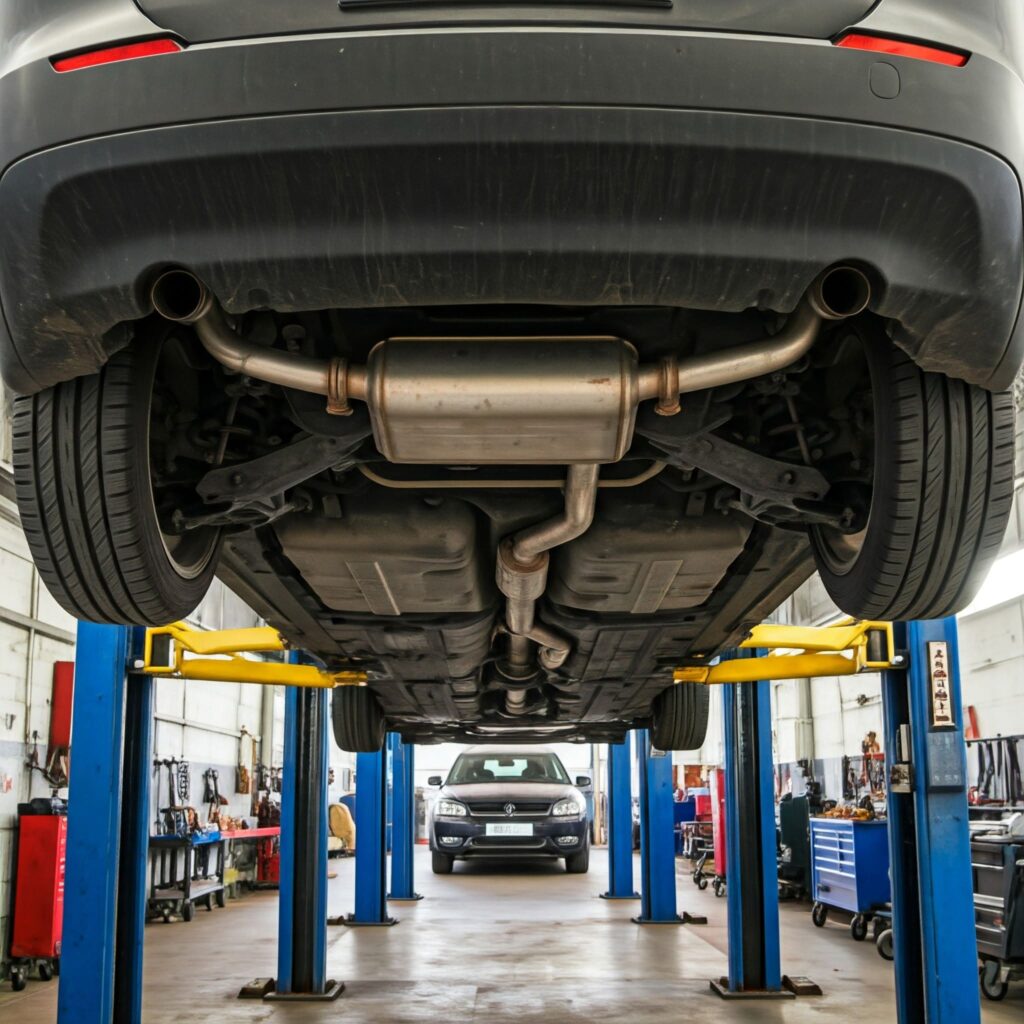Objective: This guide explores how catalytic converters work, how to test them at home, and how fuel additives and high-quality motor oils can indirectly impact their performance. Using an unbiased and authoritative approach, it provides actionable information to help readers maintain vehicle efficiency and emissions control.
Understanding the Catalytic Converter
A catalytic converter is vital for reducing vehicle emissions and maintaining engine efficiency. Located in your car’s exhaust system, it converts harmful gases into less toxic substances. These pollutants include:
- Carbon Monoxide (CO): Converted into Carbon Dioxide (CO₂.)
- Unburned Hydrocarbons: Transformed into Water Vapor (H₂O) and Carbon Dioxide.
- Nitrogen Oxides (NOx): Broken into Nitrogen (N₂) and Oxygen (O₂.)
This crucial device not only ensures your car complies with emissions standards but also promotes fuel efficiency and cleaner air.
For a deeper technical explanation of how catalytic converters function and the science behind their emissions-reducing process, refer to this expert guide by Universal Technical Institute (UTI.)
Signs of a Failing Catalytic Converter
Spotting early warning signs of a failing catalytic converter is essential for maintaining vehicle performance. Common symptoms include:
- Poor Acceleration: Sluggish response when pressing the gas pedal could indicate airflow blockages.
- Decreased Fuel Economy: A clogged converter forces the engine to work harder, consuming more fuel.
- Excessive Exhaust Smoke: Dark smoke suggests inefficient combustion in the engine.
- Unusual Smells: A sulfur or “rotten egg” odor signals unprocessed sulfur compounds in the exhaust.
- Rattling Noises: Damaged internal components can produce noticeable metallic rattling sounds.
- Check Engine Light: Modern vehicles typically alert the driver to catalytic converter issues through the onboard diagnostic system (OBD-II.)
Ignoring these issues may lead to further damage, reduced performance, increased emissions, or costly repairs.
How to Test a Catalytic Converter at Home
Testing your catalytic converter at home requires basic tools and careful attention. Here are four effective diagnostic methods:
1. Visual Inspection
Start with a physical examination for damage or blockages:
- Check for Cracks or Dents: External damage can lead to reduced efficiency.
- Rust or Corrosion: Excessive rust weakens the structure.
- Blockages: Debris clogging the converter’s inlet or outlet could hinder airflow.
Use a flashlight for a closer look at the surface and surrounding exhaust pipes.
2. Back Pressure Test
This test measures restrictions in exhaust flow:
- Locate the upstream oxygen (O2) sensor and carefully remove it.
- Attach a back-pressure gauge in place of the sensor.
- Start the engine and monitor the gauge at idle (target: ≤1.5 PSI.)
- Rev the engine to 2,500-3,000 RPM and check for readings above 3 PSI, which suggest blockages.
3. Vacuum Test
Evaluate intake manifold pressure to detect restrictions:
- Connect a vacuum gauge to the engine’s intake manifold port.
- Observe the gauge at idle (normal: 18-22 inHg.)
- Gradually increase RPMs. Significant drops in readings indicate potential converter clogs.
4. Oxygen Sensor Diagnostics
Analyze the data from the vehicle’s onboard sensors to evaluate the converter’s performance:
- Use an OBD-II scanner to check upstream and downstream oxygen sensor data.
- Stable, consistent downstream readings (in contrast to fluctuating upstream readings) suggest the converter is functioning properly.

Fuel Additives: Cleaner Combustion, Fewer Deposits
Fuel additives are designed to enhance combustion, improving engine efficiency and reducing harmful deposits that can clog the catalytic converter.
Impacts on Catalytic Converters
- Reduced Engine Deposits: Clean injectors promote efficient combustion, reducing unburned hydrocarbons that stress the converter.
- Improved Fuel Economy: More complete combustion lessens exhaust volume and reduces strain on the system.
Popular Additive Options
Some trusted brands to consider include:
- Chevron Techron: Known for its strong injector-cleaning capabilities.
- Lucas Fuel Treatment: Effective in reducing carbon buildup within fuel systems.
- AMSOIL P.i.® Performance Improver: Removes deposits and improves fuel economy, making it a reliable option.
Each product serves similar purposes, but the effectiveness varies by formulation. Ensure compatibility with your vehicle before use.
High-Quality Motor Oils: Protecting Engine and Converter Integrity
Motor oils, especially synthetic ones, play a critical role in catalytic converter health. Low-quality or overused oil can contaminate the converter, reducing its efficiency.
Impacts on Catalytic Converters
- Reduced Oil Consumption: Synthetic motor oils minimize oil burn-off, preventing oily residues from reaching the exhaust and coating the converter.
- Cleaner Operations: High-quality oils resist breakdown at high temperatures, reducing byproducts that could harm the emissions system.
Popular Oil Comparisons
- Mobil 1 Advanced Full Synthetic: Renowned for its thermal stability and engine protection.
- Castrol EDGE with Fluid Titanium Technology: Enhances performance by reducing engine friction under stress.
- AMSOIL Signature Series Synthetic Motor Oil: Offers extended drain intervals and superior resistance to thermal breakdown.
Always choose a motor oil that matches your vehicle’s specifications (e.g., viscosity grade and performance standards.)
Key Maintenance Tips
1. Routine Inspections
- Inspect the catalytic converter for physical damage or blockages every 6 months.
- Check the exhaust system for leaks or unusual noises.
2. Use Quality Fuels and Oils
- Select high-quality fuel to reduce impurities in combustion.
- Use oils specifically designed for your engine’s needs to limit contamination risks.
3. Address Engine Issues Promptly
- Resolve misfires and burning oil problems to prevent system damage.
- Avoid excessive use of additives, as they may harm certain vehicle components.

FAQs
1. Can fuel additives damage catalytic converters?
No, reputable fuel additives are formulated to be safe for catalytic converters. Always follow product guidelines.
2. Will synthetic oil improve catalytic converter performance?
Indirectly, yes. Synthetic oils reduce contamination risks by burning cleaner and minimizing residues.
3. How often should I check my catalytic converter?
Inspect it every 6 months or during routine emissions testing to ensure proper function.
Conclusion
Maintaining your catalytic converter involves regular care, strategic use of fuel additives, and high-quality synthetic motor oils. Products like Chevron Techron or AMSOIL P.i.® can optimize combustion and reduce deposits, while oils such as Mobil 1, Castrol EDGE, or AMSOIL Signature Series minimize contamination risks.
For additional technical insights about catalytic converters and their role in improving vehicle emissions, visit this resource by Universal Technical Institute (UTI.)
By combining regular inspections with thoughtful product choices, you can extend your catalytic converter’s lifespan, improve efficiency, and stay compliant with emissions standards. Take proactive steps now to avoid costly repairs later.
